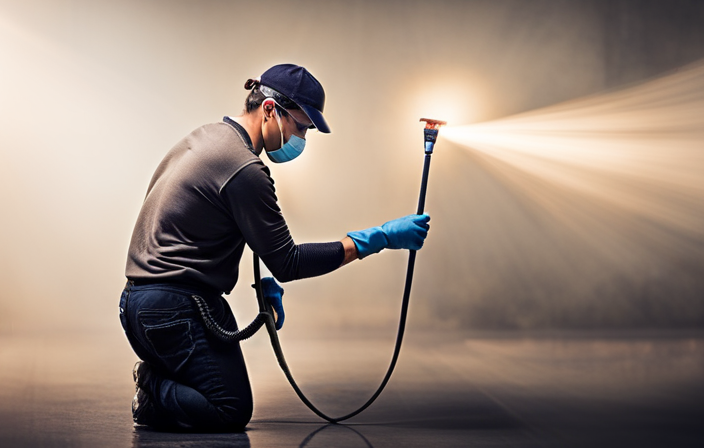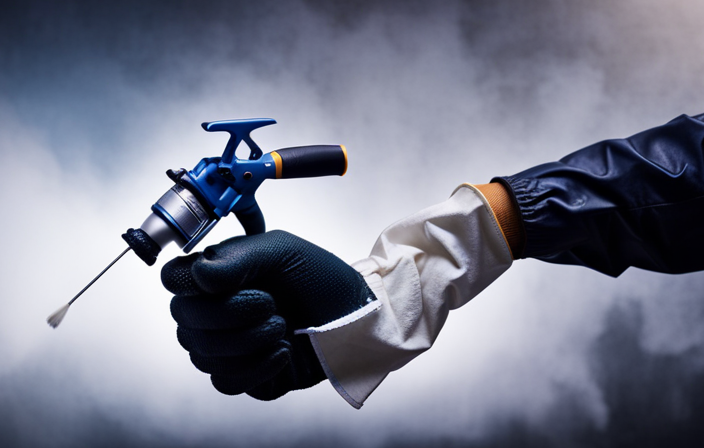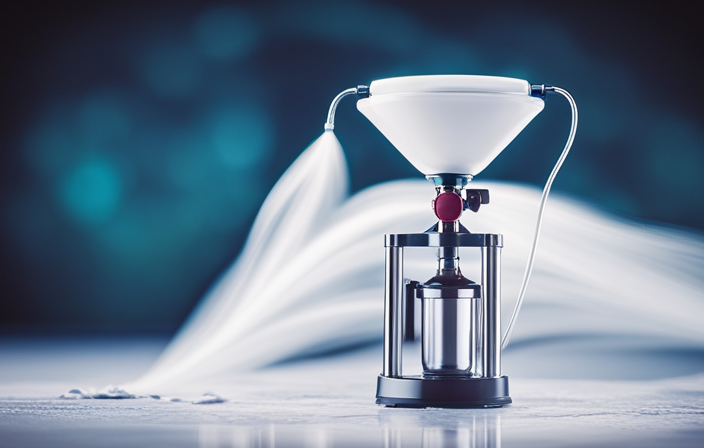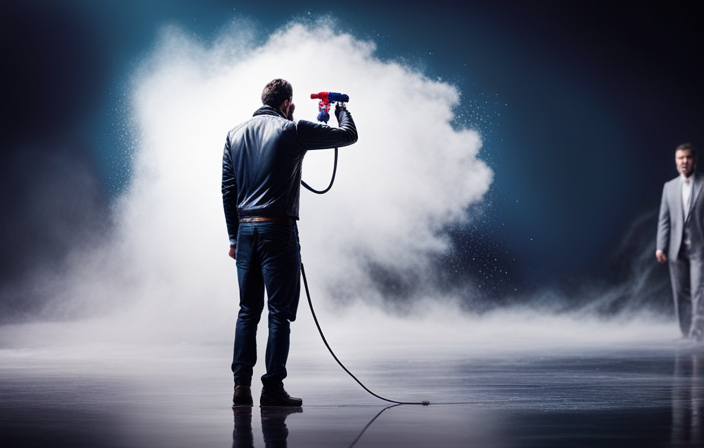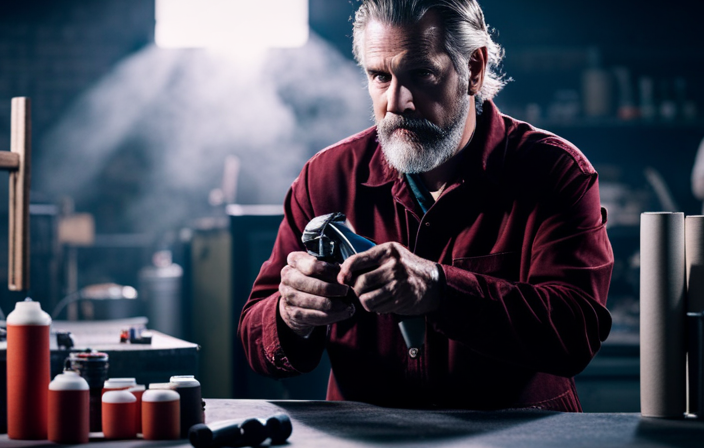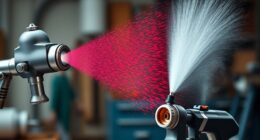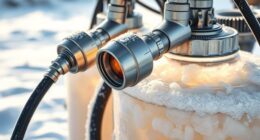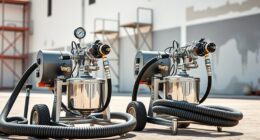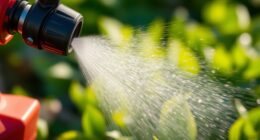Removing latex paint from an airless sprayer can be a challenging task at times. The paint may clog the sprayer, causing malfunctions and complicating the cleaning process.
But fear not! With the right supplies and a little know-how, cleaning your airless sprayer can be a breeze. In this article, I will guide you through the step-by-step process of cleaning your sprayer, ensuring that it is ready for your next painting project.
From disconnecting and emptying the sprayer to scrubbing off the paint and properly disposing of any leftover materials, I will provide you with the knowledge and techniques needed to get your sprayer looking and working like new.
So, let’s dive in and learn how to clean latex paint from an airless sprayer!
Key Takeaways
- Disconnect and empty the sprayer, ensuring all paint is removed and the pressure is released.
- Use warm soapy water or a vinegar solution to effectively clean the sprayer, scrubbing with a brush or sponge.
- Rinse the sprayer thoroughly with clean water to remove any residue.
- Check for any remaining paint and repeat the cleaning process if necessary, ensuring the sprayer is completely clean before storing or reassembling.
Gather the necessary supplies
Before you dive into the process of cleaning your airless sprayer, make sure you’ve got all the necessary supplies at hand. Proper storage techniques for airless sprayers and common mistakes to avoid when using one are important discussion points in this section.
To clean the latex paint from your airless sprayer, you’ll need a few things: a bucket or container to catch the waste paint, a cleaning solution specifically designed for latex paint, a cleaning brush or sponge, and protective gloves and goggles. These supplies are essential for ensuring a thorough and safe cleaning process.
Once you have everything ready, we can move on to the next section where we will discuss how to disconnect and empty the paint sprayer, getting it ready for cleaning.
Disconnect and empty the paint sprayer
After you’re finished with the job, make sure to disconnect and empty out the container, which can hold up to 5 gallons of paint, leaving you with a sense of accomplishment. To disconnect the paint sprayer, follow these steps:
- Turn off the power switch and unplug the sprayer from the power source.
- Release the pressure in the system by activating the trigger until no paint comes out.
- Disconnect the hose from the sprayer by unscrewing it counterclockwise.
Once the sprayer is disconnected, it’s time to empty any remaining paint residue. Tilt the sprayer over a paint bucket and allow the remaining paint to flow out. To ensure thorough cleaning, wipe the container and the hose with a clean cloth.
Now that the sprayer is disconnected and emptied, we can move on to removing any excess paint from the sprayer.
Remove any excess paint from the sprayer
To ensure a smooth and hassle-free clean up, take a moment to remove any extra paint lingering inside the sprayer.
Cleaning techniques for latex paint from airless sprayers can vary, but there are a few alternative cleaning methods you can consider. One method is to use a small brush or scraper to gently remove any paint buildup from the inside of the sprayer. Another option is to use a cleaning solution specifically designed for removing latex paint, which can be sprayed into the sprayer and then flushed out with water. It’s important to thoroughly clean the sprayer to prevent any residual paint from clogging the nozzle or causing future issues.
Moving on to the next step, we’ll discuss how to use warm soapy water to clean the sprayer.
Use warm soapy water to clean the sprayer
For an effective cleaning process, you can easily maintain the performance of your equipment by using warm soapy water and ensuring that all areas are thoroughly cleaned.
Cleaning latex paint from an airless sprayer can be done by using a vinegar solution for paint removal. This solution helps to break down the paint and make it easier to clean off. Additionally, using specialized paint sprayer cleaning solutions can provide even better results. These solutions are specifically designed to remove latex paint and can help to dissolve any stubborn residues.
After using warm soapy water and the vinegar solution or specialized cleaning solution, you can proceed to the next step of the cleaning process. Use a brush or sponge to scrub the paint off, ensuring that you remove all traces of paint from the sprayer.
Use a brush or sponge to scrub the paint off
Scrubbing the paint off with a brush or sponge will ensure a thorough clean. Here’s why using a brush or sponge to remove the latex paint from your airless sprayer is beneficial:
- The bristles of a brush can reach into tight spots and crevices, ensuring that all the paint is removed.
- A sponge can be used to gently scrub the surface of the sprayer, effectively lifting off the paint without damaging any delicate parts.
- Using a brush or sponge allows for better control and precision in removing the paint, especially when compared to other cleaning methods.
- The brush or sponge can be easily maneuvered around the different components of the sprayer, ensuring that every nook and cranny is thoroughly cleaned.
After scrubbing off the paint, it’s important to rinse the sprayer thoroughly with clean water to remove any remaining residue. This step will ensure that the sprayer is ready for its next use.
Rinse the sprayer thoroughly with clean water
After scrubbing off the paint, the next crucial step is to thoroughly rinse the sprayer with fresh water, ensuring a pristine and ready-to-use tool for your next project.
To achieve optimal results, I recommend using vinegar as a cleaning agent. Vinegar is a natural and effective solution that helps break down and remove stubborn latex paint residues. Simply mix equal parts vinegar and water in a bucket, then use a clean cloth or sponge to wipe down all surfaces of the sprayer.
Once the vinegar solution has been applied, rinse the sprayer thoroughly with clean water to remove any remaining paint and vinegar residue. For a more efficient cleaning process, consider using a pressure washer. The high-pressure water stream will help remove paint particles more effectively, leaving your sprayer spotless.
After rinsing, check for any remaining paint and repeat the cleaning process if necessary, ensuring a fully clean and paint-free sprayer for your next paint job.
Check for any remaining paint and repeat the cleaning process if necessary
Once you think you’ve removed all the paint from the sprayer, be sure to double-check for any lingering traces and repeat the cleaning process if necessary.
It’s crucial to ensure that no remaining paint is left in the sprayer, as it can lead to clogging and affect the performance of the equipment. To remove any remaining paint, inspect the sprayer carefully, paying close attention to the nozzle, filters, and other parts where paint may accumulate.
Use a clean cloth or brush to remove any stubborn paint residues. If necessary, repeat the cleaning process, following the same steps as before. By thoroughly removing all traces of paint, you can prevent any complications and maintain the sprayer’s efficiency.
Once the sprayer is free of paint, proceed to dry it completely before storing or reassembling, ensuring its longevity and optimal functioning.
Dry the sprayer completely before storing or reassembling
Make sure to thoroughly dry the sprayer before you store or reassemble it, ensuring that it remains in top condition for your next paint job. Properly drying the sprayer is crucial to prevent any damage or malfunctions. To assist you in this process, refer to the following table for some reassembly tips and preventing paint buildup:
| Reassembly Tips | Preventing Paint Buildup |
|---|---|
| Lubricate O-Rings | Clean Filters Regularly |
| Tighten Connections | Use a Strainer |
| Replace Worn Parts | Flush the System |
| Check for Leaks | Use Proper Cleaning Solvents |
By following these tips, you can maintain the sprayer’s performance and prolong its lifespan. Once the sprayer is completely dry, you can move on to the next step of cleaning any additional parts or accessories, such as nozzles or filters, to ensure they are also ready for future use.
Clean any additional parts or accessories, such as nozzles or filters
To ensure optimal performance, don’t forget to tidy up any extra components like nozzles or filters. Cleaning these parts is essential for maintaining the efficiency of your airless sprayer.
Here are some cleaning techniques and maintenance tips to follow:
- Remove the nozzles and filters carefully to prevent any damage.
- Rinse them thoroughly with warm water to remove any paint residue.
- Use a soft brush or toothbrush to scrub away any stubborn paint particles.
- Allow the parts to dry completely before reassembling the sprayer.
Properly cleaning these additional components will help prolong the lifespan of your airless sprayer and ensure consistent paint application.
Now, let’s move on to the next section about how to properly dispose of any leftover paint or cleaning materials.
Properly dispose of any leftover paint or cleaning materials
Have you ever wondered what to do with any leftover paint or cleaning materials after using your airless sprayer? Properly disposing of these items is essential for environmental safety. When it comes to latex paint, there are specific disposal methods you should follow. First, check with your local waste management facility for any regulations or guidelines regarding paint disposal. In many cases, you can solidify the paint by mixing it with an absorbent material, such as cat litter or sawdust, before disposing of it in the regular trash. As for cleaning materials like paint brushes and rollers, it is crucial to clean them properly to prolong their lifespan. Rinse them thoroughly with water and use a mild detergent if necessary. Avoid pouring any leftover paint or cleaning solutions down the drain, as it can contaminate water sources. By following these steps, you can safely dispose of leftover paint and clean your tools without harming the environment.
| Advantages | Disadvantages |
|---|---|
| Protects the environment | Requires additional time and effort |
| Prevents water pollution | May incur additional disposal costs |
| Promotes sustainable practices | Limited disposal options in some areas |
Frequently Asked Questions
Can I use any type of soap to clean the sprayer, or is there a specific type I should use?
I recommend using a mild dish soap or a specialized paint thinner to clean the sprayer. Avoid using harsh chemicals as they can damage the sprayer. For removing latex paint from other surfaces, use a mixture of warm water and mild soap.
How often should I clean my paint sprayer to ensure optimal performance?
Cleaning the paint sprayer regularly is crucial for optimal performance. It ensures consistent paint flow, minimizes clogs, and extends the sprayer’s lifespan. I recommend cleaning it thoroughly after each use to maintain its efficiency.
Is it necessary to disassemble the sprayer before cleaning, or can I clean it while it’s still assembled?
It is highly recommended to disassemble the sprayer before starting the cleaning process. This allows for a more thorough cleaning and ensures that all parts are properly cleaned and maintained, resulting in optimal performance and longevity of the sprayer.
Can I use a pressure washer or hose to rinse the sprayer instead of clean water?
Using a pressure washer or hose to rinse the sprayer instead of clean water? Absolutely! It’s a fantastic idea if you want to risk damaging the delicate parts of your sprayer and potentially causing a safety hazard. Always prioritize pressure washer safety and stick to traditional cleaning methods.
What should I do if there is dried paint on the sprayer that is difficult to remove?
If there is dried paint on the sprayer that is difficult to remove, I recommend using effective cleaning techniques such as soaking the parts in a solvent, scrubbing with a brush, or using a heat gun to soften the paint for easier removal.
Conclusion
After following these precise steps to clean latex paint from your airless sprayer, you’ll be amazed at the sparkling results. Your sprayer will shine like a polished gem, ready to tackle any future painting project with ease.
The satisfaction of a job well done will wash over you like a refreshing wave, leaving you inspired and motivated to take on more DIY endeavors. So bid farewell to stubborn paint and embrace the pristine beauty of your sprayer. Happy painting!
